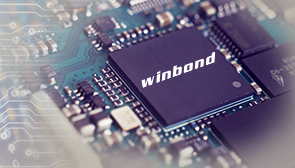Embedded World: Winbond Unveils Automotive-Grade SLC NAND Flash ICs
At densities of 512Mb and above ro replace NOR
This is a Press Release edited by StorageNewsletter.com on March 9, 2018 at 2:28 pmWinbond Electronics Corporation unveiled a new class of NAND flash ICs which offers quality and long data retention suitable for use in mission-critical code storage applications at densities of 512Mb (64MB) and above.

These company’s automotive-grade SLC HQ (High Quality) serial NAND flash parts will enable automotive system manufacturers to implement code storage in sophisticated new applications such as autonomous driving systems, which typically require capacity of 512Mb (64MB) or more, at a much lower cost-per-bit than the conventional choice of NOR flash offers.
This superior option for code storage is possible because the company has implemented new production and testing processes to eliminate the bit errors which occur in the operation of conventional NAND flash devices. It has implemented these processes at the 46nm node – rather than the 1xnm and 2xnm nodes used by manufacturers of high-density consumer NAND flash – to provide a higher electron count-per-cell, and thus to extend data retention time. These approaches ensure that the reliability of its HQ NAND flash matches that of equivalent NOR flash devices on the market.
The company’s guarantees that all new automotive-grade HQ serial NAND and/or Quad SPI NAND (QSPI_NAND) flash parts, which have a serial peripheral interface, will have no bad blocks on shipment and for up to 100 program/erase cycles – sufficient for code storage applications, which perform a limited number of program and erase operations. This eliminates the need for bad block management, making automotive-grade HQ NAND flash as easy to integrate in system designs as NOR flash.
In addition, the firm’s HQ NAND flash supports 25 years’ data retention at an operating temperature of 85°C in cells subject to up to 100 P/E cycles. The company’s test data also demonstrates support for more than 15 years’ data retention at 70°C after 10,000 P/E cycles, which is comparable to the performance of NOR flash products on the market.
The company’s development of a automotive-grade SLC HQ NAND flash is a response to the seemingly insurmountable problem of NOR flash scaling. The usual shrinking of semiconductor processes as predicted by Moore’s Law slowed dramatically for NOR flash at 65nm, and appears to hit a complete roadblock at 45nm. Meanwhile, car makers are looking to implement new compute-intensive applications such as Advanced Driver Assistance Systems (ADAS), autonomous driving systems and LIDAR range finding, which require higher densities of code storage than automotive designs traditionally use. This means that, if automotive system manufacturers continue to use NOR flash, the cost of the high-reliability memory component of their designs is set to rise steeply.
Firm’s development of HQ NAND flash for code storage provides a pathway to a lower and decreasing cost-per-bit in these applications, because NAND flash scaling continues. The HQ NAND flash parts available and in development today are fabricated in a 46nm process. The company has a roadmap for progression of its HQ NAND flash process to the 32nm node, maintaining automotive-grade quality at lower cost-per-bit.
“Because of the inability of NOR Flash to scale below 45nm, the high cost-per-bit of NOR for code storage is built into the bill-of-materials cost – there is no prospect of it falling as demand for higher densities rises. Winbond has solved this problem by enabling the use of NAND flash instead, at less than half the cost-per-bit of 45nm NOR flash today and with a clear route to an even better cost-per-bit at the next 3xnm node,” said Syed S. Hussain, director, flash marketing, Winbond.
The firm’s 46nm NAND flash parts in densities of 512Mb (64MB) and 1Gb (128MB) are available for sampling.
The 512Mb HQ Serial NAND W25N512GW and 1Gb HQ Serial NAND W25N01GW operate at a supply voltage of 1.8V. The 512Mb HQ Serial NAND W25N512GV and 1Gb HQ Serial NAND W25N01GV operate at 3V.
For designs migrating from SPI NOR parts at densities of 256Mb (32MB) and below to the serial NAND parts in 512Mb or 1Gb densities, the pin-out and footprint remain the same, providing for a transition from SPI NOR to serial NAND.
The firm introduced the automotive-grade HQ serial NAND flash family to visitors to the Arrow Electronics at Embedded World 2018 (Nuremberg, Germany, 27 February – 1 March).
Winbond’s major products include specialty DRAM, mobile DRAM, and Code Storage Flash Memory. Its Winbond’s memory business revenue in 2017 were at about $1.25 billion. It has approximately 2,800 employees worldwide with offices in Taiwan, Hong Kong, China, Japan, Israel and USA.














 Subscribe to our free daily newsletter
Subscribe to our free daily newsletter


